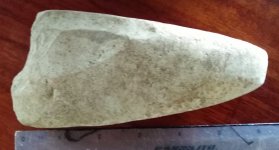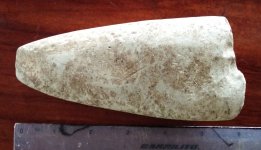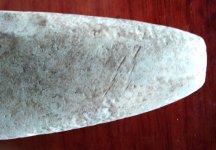BillA
Bronze Member
humor me guys, I don't even know how to phrase my questions
recently saw a hacha or celt/axe, ~8" OAL with damage to the blade and its subsequent repair by flaking


pecking is clear on all sides, but the blade and tip are ground

my questions relate to the material used
the axe has been laying on the surface of the jungle for 1000 years or so, and all stone does weather
where old moss was attached seems slightly higher suggesting some protection ?
but the rock to me appears to be consolidated clay, super fine grain w/o inclusions
good for pecking and grinding but not flaking
but the repair, keeping the CL of the blade constant, was done by flaking
what defines if a stone can be flaked ?
thanks
edit: closest I could find was https://geology.com/rocks/novaculite.shtml but seems much harder
recently saw a hacha or celt/axe, ~8" OAL with damage to the blade and its subsequent repair by flaking


pecking is clear on all sides, but the blade and tip are ground

my questions relate to the material used
the axe has been laying on the surface of the jungle for 1000 years or so, and all stone does weather
where old moss was attached seems slightly higher suggesting some protection ?
but the rock to me appears to be consolidated clay, super fine grain w/o inclusions
good for pecking and grinding but not flaking
but the repair, keeping the CL of the blade constant, was done by flaking
what defines if a stone can be flaked ?
thanks
edit: closest I could find was https://geology.com/rocks/novaculite.shtml but seems much harder
Last edited:




